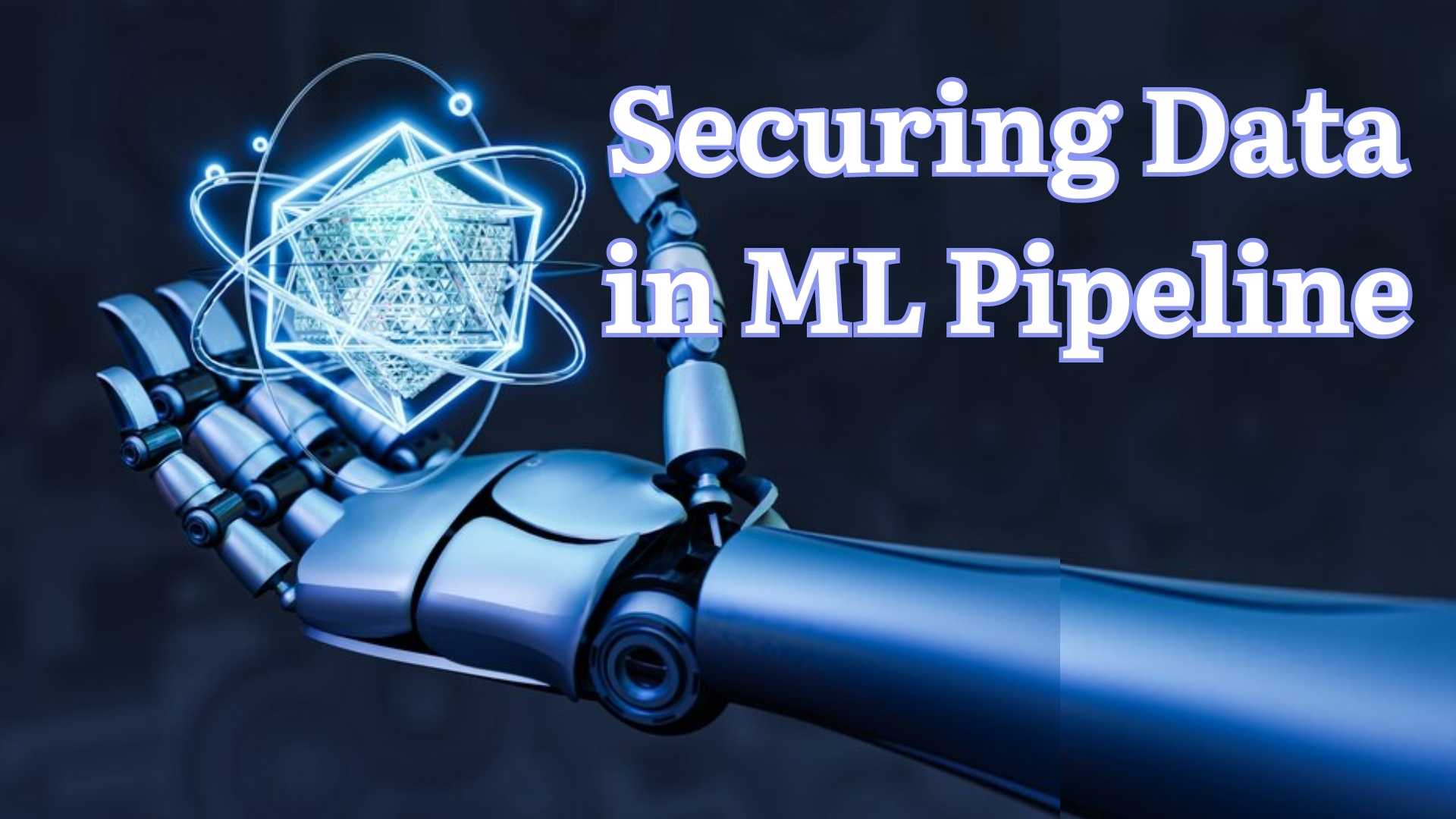Ensure data security throughout your ML pipeline with this comprehensive MLOps Deployment Manual. Learn best practices for safeguarding sensitive data at every stage, from acquisition to deployment, mitigating risks, and ensuring compliance with regulations. A must-have resource for ML practitioners prioritizing data privacy and security.
Safeguarding ML Pipeline: Insights into Data Security
In today’s data-driven world, Machine Learning (ML) models are increasingly shaping critical decisions across diverse industries. However, the success of these models hinges on the security and integrity of the data they utilize. As the complexities of ML pipelines grow, ensuring data security throughout the entire lifecycle becomes paramount. This chapter delves into the challenges and best practices for securing data in the ML pipeline and empowering MLOps professionals to build robust and trustworthy ML systems.
Strengthening Data Protection in the ML Pipeline Framework
ML pipelines involve the collection, storage, processing, and utilization of often sensitive data. This data could include:
- Personally identifiable information (PII) like names, addresses, or financial data.
- Commercially sensitive information like proprietary research data or customer information.
- Protected health information (PHI) is subject to strict regulations.
The Importance of Securing Data in the ML Pipeline
Securing data throughout the ML pipeline goes beyond just ticking a box – it’s vital for safeguarding privacy, complying with regulations, ensuring model integrity, and building trust. Let’s delve deeper into why each of these aspects holds significant importance.
1. Mitigating Privacy Risks:
Modern ML pipelines often handle sensitive data, encompassing personally identifiable information (PII) like names, addresses, or financial data, as well as commercially sensitive information like proprietary research or customer information. Additionally, in specific domains like healthcare, protected health information (PHI) further elevates the sensitivity level. Unsecured data within the pipeline leaves it vulnerable to unauthorized access or misuse, potentially leading to:
- Identity theft: Exposed PII can be misused for fraudulent activities like opening accounts or obtaining loans under false pretenses, causing significant harm to individuals.
- Financial loss: Compromised financial data could be used for unauthorized transactions, leading to financial losses for individuals or organizations.
- Reputational damage: Breaches involving sensitive data can severely damage the reputation of organizations, eroding trust and impacting customer relationships.
Therefore, implementing robust security measures becomes crucial to protect individuals and organizations from these potential risks, safeguarding their privacy and well-being.
2. Ensuring Regulatory Compliance:
The landscape of data privacy regulations is rapidly evolving, with various jurisdictions implementing stringent measures to protect individuals’ data rights. Prominent examples include the General Data Protection Regulation (GDPR) in the European Union and the California Consumer Privacy Act (CCPA) in the United States. These regulations outline specific requirements for collecting, storing, and utilizing personal data, placing a compliance burden on organizations that utilize such data in their ML pipelines. Failure to comply can result in significant financial penalties and reputational damage, jeopardizing the organization’s operations and public image.
By securing data throughout the pipeline, MLOps teams demonstrate their commitment to responsible data practices and ensure compliance with relevant regulations. This minimizes legal risks and fosters trust with stakeholders like regulators and consumers.
3. Maintaining Data Integrity:
The integrity of data is paramount for reliable and trustworthy ML models. This means ensuring that the data used for training and analysis is accurate, complete, and free from unauthorized modifications or tampering. Unsecured data within the pipeline is vulnerable to:
- Accidental errors: Human error during data processing or storage can introduce inconsistencies into the data, leading to skewed results and unreliable model outputs.
- Malicious attacks: Hackers may attempt to manipulate the data to influence the model’s behavior, potentially leading to biased or inaccurate predictions with detrimental consequences.
Securing data helps maintain data integrity by safeguarding it from unauthorized modifications or errors. This, in turn, ensures that the ML model learns from reliable and accurate information, ultimately leading to more robust and trustworthy predictions.
4. Building Trust and Transparency:
In today’s data-driven world, transparency and trust are paramount to ensure responsible and ethical AI development. Consumers and stakeholders increasingly demand insights into how organizations handle their data, particularly when it’s used in ML models that impact their lives. By implementing robust data security measures, MLOps teams demonstrate a commitment to responsible data governance. They transparently communicate their security practices and safeguards, fostering trust with stakeholders and demonstrating their commitment to protecting sensitive information.
Securing data within the ML pipeline is not just a technical challenge but an essential aspect of ethical and responsible AI development. It protects individuals and organizations, ensures compliance with regulations, safeguards the integrity of models, and builds trust with stakeholders. By embracing data security as a core principle, MLOps teams can pave the way for the responsible development and deployment of beneficial and trustworthy AI solutions.
Challenges in Securing Data in the ML Pipelines
Several challenges hinder the effective implementation of data security best practices in MLOps:
- Complexity of ML Pipelines: Modern ML pipelines often involve diverse tools, services, and distributed environments, making it challenging to maintain a consistent security posture across all components.
- Data Sharing and Access Control: Sharing data across different teams and organizations within and outside the enterprise necessitates robust access controls to ensure that only authorized users can access specific data for specific purposes.
- Evolving Threat Landscape: The ever-evolving landscape of cyber threats requires continuous vigilance and adaptation of security practices to stay ahead of potential adversaries.
- Data Privacy Regulations: Understanding and adhering to a growing number of data privacy regulations across different regions and jurisdictions can be complex and resource-intensive.
Best Practices for Securing Data in the ML Pipeline
MLOps teams can implement several best practices to secure data throughout the ML pipeline:
1. Data Governance and Access Control:
- Establish clear data governance policies: Define clear guidelines for data ownership, access, and usage within the organization. These policies should specify who has access to which data, under what conditions, and for what purposes.
- Implement robust access controls: Utilize role-based access control (RBAC) to grant access to specific data based on the user’s role and responsibilities. Multi-factor authentication (MFA) should be implemented for additional access security.
- Data minimization: Collect and store only the data necessary for specific ML tasks. Avoid over-collection and retention of sensitive data beyond its required use case.
2. Data Encryption and Anonymization:
- Data encryption at rest and in transit: Encrypt data at rest on storage systems and during transmission between different components of the pipeline. This protects sensitive information from unauthorized access even if attackers gain access to the system.
- Data anonymization or pseudonymization: Consider anonymizing or pseudonymizing sensitive data before using it for model training or analysis. This reduces the risk of compromising individual identities while still retaining relevant information for model development.
- Homomorphic encryption: Explore applying homomorphic encryption techniques that allow computations to be performed on encrypted data without decryption. This can be particularly beneficial for scenarios where model training requires access to sensitive information.
3. Secure Development and Infrastructure:
- Secure coding practices: Implement secure coding practices throughout the ML pipeline development process to identify and mitigate potential security vulnerabilities in the code.
- Leverage secure platforms and infrastructure: Utilize cloud platforms and infrastructure that offer robust security features like intrusion detection, vulnerability management, and data encryption capabilities.
- Regular security assessments: Conduct regular penetration testing and vulnerability assessments on the ML pipeline to identify and address potential security weaknesses before they can be exploited by attackers.
4. Monitoring and Logging:
- Implement comprehensive monitoring and logging: Monitor system activity throughout the pipeline to identify any suspicious behavior or potential security incidents. Log all access attempts, data modifications, and other relevant events for auditability and incident response purposes.
- Regular review and analysis of logs: Regularly review and analyze logs to identify any suspicious activities and investigate potential security threats promptly.
5. Security Awareness and Training:
- Regular employee training: Conduct regular training sessions to keep MLOps personnel informed of the latest cyber threats and attack vectors, empowering them to recognize and report suspicious activity.
- Incident response protocol: Establish a clear incident response protocol outlining the steps to be taken in case of a security breach or data leak. This includes notifying the appropriate authorities, conducting root cause analysis, and implementing corrective measures to prevent future incidents.
6. Continuous Improvement:
- Regularly evaluate the effectiveness of your data security practices: Regularly assess the effectiveness of your data security measures through penetration testing, vulnerability assessments, and internal audits. Identify areas for improvement and adapt your security posture based on evolving threats and regulations.
- Embrace new technologies: Stay informed and adapt to emerging security technologies that can enhance data protection in the ML pipeline. This might include utilizing blockchain technology for secure data sharing or exploring advanced encryption techniques like quantum-resistant cryptography.
Securing data in the ML pipeline is a continuous process that requires collaboration between MLOps teams, data scientists, and security professionals. By implementing the best practices outlined in this chapter and fostering a culture of security awareness within the organization, MLOps professionals can build and operate robust, secure, and trustworthy ML pipelines, ultimately contributing to the responsible and ethical development of AI-powered applications.

Additional Considerations for Securing Data in the ML Pipeline
While securing data throughout the ML pipeline is crucial, a holistic approach requires considering additional aspects beyond the fundamental principles discussed earlier. These considerations delve deeper into ethical considerations, emerging technologies, and regulatory compliance, paving the way for a comprehensive data security strategy:
1. Model Explainability and Interpretability (XAI):
Securing data extends beyond protecting its confidentiality and integrity. It also involves understanding how data is utilized within the model. Implementing XAI techniques like LIME or SHAP allows for greater interpretability of the model’s decision-making process. This can uncover potential issues like data biases or unintended consequences that might have security implications. For instance, an XAI analysis might reveal that a model disproportionately relies on certain features correlated with sensitive data attributes, potentially breaching data privacy principles. By understanding these nuances, MLOps teams can address potential vulnerabilities and ensure responsible data utilization within the model.
2. Data Privacy-enhancing Technologies (DPETs):
Balancing data utility with privacy is a growing concern. DPETs offer promising solutions that enable data utilization for model development while preserving data privacy. Notably:
- Differential privacy: This technique adds carefully calibrated noise to the data, ensuring statistical accuracy while obfuscating individual details, minimizing the risk of identifying specific data points.
- Federated learning: This approach trains the model on decentralized data sets stored on individual devices or servers. This avoids centralizing sensitive data, reducing the risk of breaches and enabling collaboration without compromising individual privacy.
Exploring DPETs allows MLOps teams to secure sensitive data while still deriving valuable insights for model development, addressing privacy concerns and fostering ethical data practices.
3. Compliance with Evolving Regulations:
The regulatory landscape surrounding data privacy is constantly evolving. MLOps teams need to be proactive in staying updated on new regulations like GDPR and CCPA, as well as emerging regulations that might impact their specific industry or region. This requires ongoing monitoring of regulatory updates and adapting data security practices to ensure compliance. Additionally, collaboration with legal experts can be crucial for navigating the complexities of data privacy regulations and ensuring the organization’s adherence to legal requirements.
4. Ethical Considerations:
Securing data goes beyond technical safeguards. It entails embedding ethical considerations throughout the ML pipeline. MLOps teams need to acknowledge and address potential ethical concerns related to data security, such as:
- Fairness and bias: Utilizing data free of inherent biases is crucial to avoid discriminatory or unfair outcomes. MLOps teams should actively address potential biases in data collection, processing, and model development.
- Transparency and accountability: Stakeholders need to understand how their data is used and protected. MLOps teams should strive for transparency in their data security practices and be accountable for ensuring responsible data handling throughout the pipeline.
By integrating ethics into their data security strategies, MLOps teams showcase their commitment to responsible AI development, fostering trust with stakeholders and minimizing potential harm or bias associated with data utilization within the ML pipeline.
In conclusion, securing data in the ML pipeline involves a multi-faceted approach. MLOps teams must go beyond basic security measures and embrace XAI for model transparency, leverage DPETs for privacy-preserving data utilization, stay updated on evolving regulations, and integrate ethical considerations into their overall strategy. By embracing these additional considerations, MLOps teams can build robust and secure ML pipelines that are not only technically sound but also ethically responsible, fostering trust and building the foundation for trustworthy and beneficial AI applications.
FAQ’s:
1: Why is securing data in ML pipelines important?
Securing data in ML pipelines is crucial to protect privacy, comply with regulations, maintain data integrity, and build trust with stakeholders.
2: What are the potential risks of unsecured data in ML pipelines?
Unsecured data can lead to identity theft, financial loss, reputational damage, and compromised model integrity due to unauthorized access or misuse.
3: How can MLOps teams ensure compliance with data privacy regulations?
MLOps teams can ensure compliance by implementing robust security measures, transparently communicating security practices, and regularly assessing and adapting to evolving regulations.
4: What best practices can be adopted to secure data in ML pipelines?
Best practices include implementing data governance and access control, encrypting and anonymizing data, securing development infrastructure, monitoring and logging, providing security awareness training, and continuously improving security measures.
5: What additional considerations are important for securing data in ML pipelines?
Additional considerations include ensuring model explainability and interpretability, exploring data privacy-enhancing technologies, staying compliant with evolving regulations, and integrating ethical considerations into data security strategies.









